Overview
This article dives into ten key strategies that can help you succeed in the world of direct-to-consumer (DTC) ecommerce. It’s all about innovation, understanding your consumers, personalizing experiences, and embracing sustainability. Each strategy comes with real-life examples and statistics that show how businesses can boost customer engagement, streamline operations, and adapt to the ever-changing market demands.
So, how can you thrive in this competitive ecommerce landscape? Let’s explore these strategies together!
Introduction
The landscape of direct-to-consumer (DTC) ecommerce is changing fast, thanks to innovative technologies and evolving consumer expectations. Have you ever wondered how manufacturers and brands can connect more deeply with their customers? Understanding the key strategies for success in this bustling environment is essential. What challenges do they encounter, and how can they adapt effectively to stay ahead? In this article, we’ll explore ten essential strategies that not only boost customer engagement but also set brands up for sustainable growth in the competitive DTC marketplace.
GenAlpha Technologies: Transforming DTC with Innovative eCommerce Solutions
GenAlpha Technologies is leading the way in reshaping the direct to consumer ecommerce landscape with its innovative solutions tailored for manufacturers and distributors. Their flagship product, Equip360, does more than just optimize inventory management; it significantly boosts digital sales performance, helping businesses connect with clients more effectively. With cutting-edge digital warranty management and robust analytics tools, GenAlpha empowers clients to streamline their operations and enhance client satisfaction. This all-encompassing approach positions GenAlpha as a key player in the direct to consumer ecommerce sector, where a whopping 82% of manufacturers agree that selling directly strengthens client relationships and experiences.
Success stories are everywhere! Take Humphrey Service Parts, for instance. They utilized Equip360 to launch their new eCommerce website, marking a major milestone in their digital journey. This implementation has resulted in improved client engagement and increased sales efficiency, highlighting the real benefits of adopting such solutions. Did you know the B2B eCommerce industry is expected to surpass $3 trillion by 2027? This figure underscores the immense sales potential for aftermarket businesses that embrace direct to consumer ecommerce strategies. As consumer habits shift towards direct interaction with brands, manufacturers are increasingly adopting direct to consumer ecommerce solutions to meet the changing market demands.
Experts emphasize the importance of choosing the right eCommerce provider with specialized knowledge in aftermarket sales to fuel growth. With the at a compound annual growth rate of 15.4%, manufacturers need to stay ahead of the curve by implementing scalable solutions that cater to their unique needs. Additionally, seamless integration with backend systems is vital for optimizing operations and boosting efficiency. GenAlpha Technologies isn’t just providing tools; they are driving a paradigm shift in how manufacturers and distributors connect with their clients in this digital age.
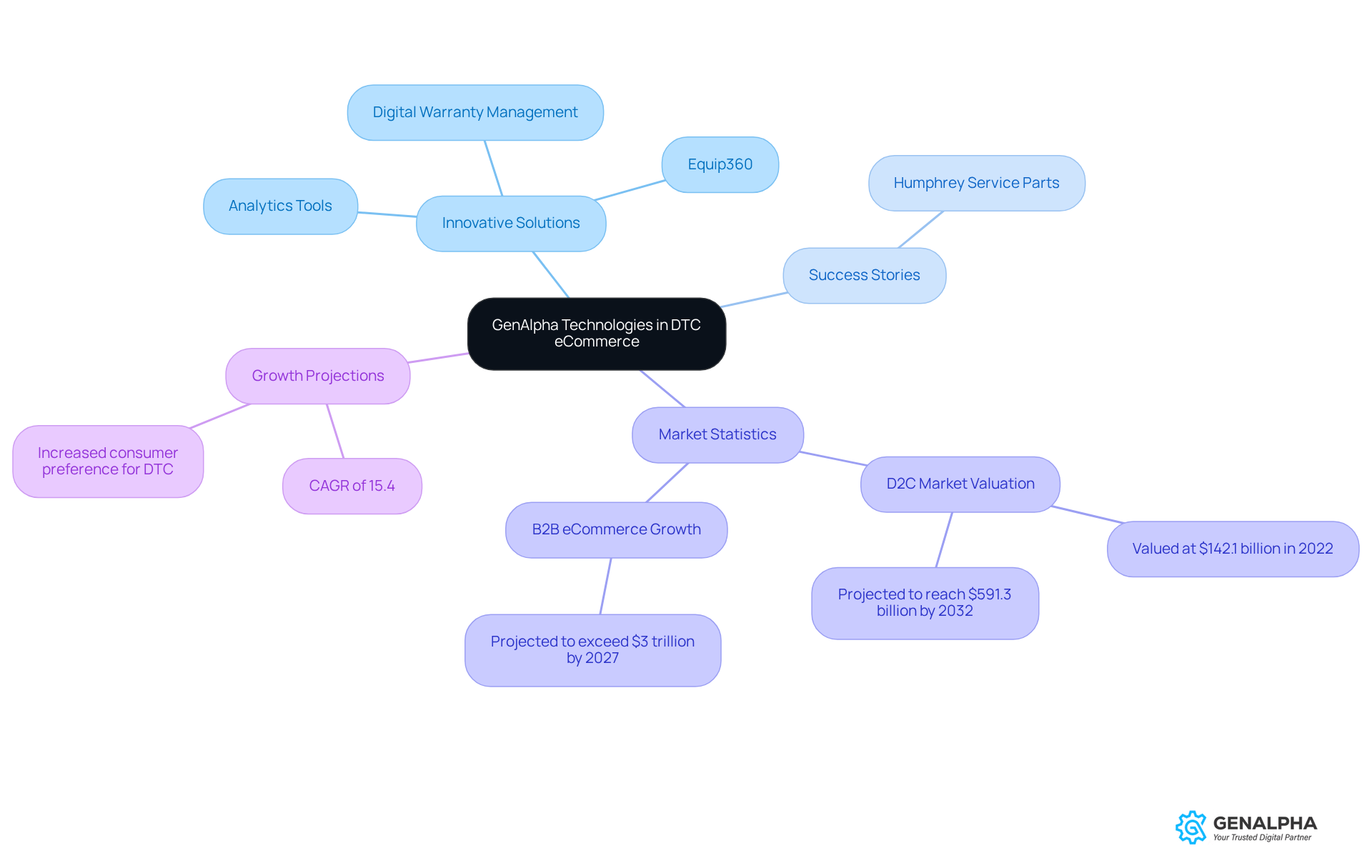
Digital Native Brands: Pioneering the DTC Revolution
Have you ever noticed how digital native companies like Warby Parker and Allbirds are shaking things up in the direct to consumer ecommerce space? They’re really leading the charge, using their online-first strategies to build solid relationships with their customers. These brands are all about engaging directly with their audience, leveraging social media and personalized marketing to boost loyalty.
Take Warby Parker, for instance. Their home try-on program lets you experience their products before you buy—how cool is that? And then there's Allbirds, which really shines a light on sustainability in its messaging, appealing to those of us who care about the planet. It’s this kind of agility and innovative thinking that not only meets the ever-changing market demands but also sets a benchmark for traditional companies looking to transition to direct to consumer ecommerce.
Looking ahead to 2025, it’s exciting to think that digital native companies are expected to capture a significant share of the direct to consumer ecommerce market. This trend really underscores how effective their strategies are at with customers. So, what do you think? Are you ready to support brands that are making a difference?
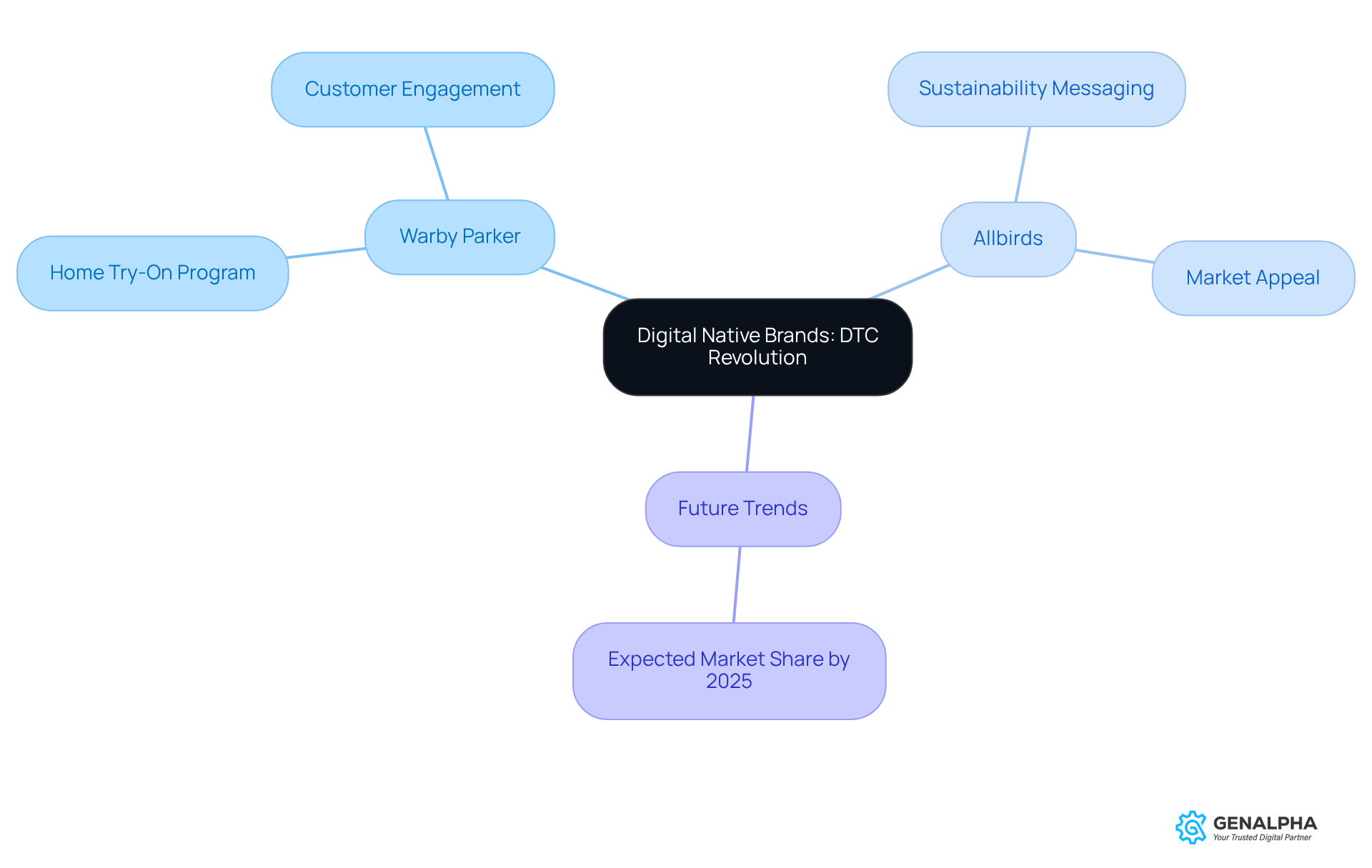
Consumer Insights: The Key to Successful DTC Strategies
When it comes to effective , understanding buyers is key. Have you ever thought about how your shopping habits influence what brands offer? Brands really need to dive into purchasing behaviors, preferences, and feedback to tailor their offerings just right. By using tools like surveys and social media analytics, companies can get a solid grasp of their target audience. This data-driven approach not only enhances product development but also shapes marketing strategies, helping brands connect with you on a personal level.
Did you know that about 40% of U.S. manufacturers are now selling directly to buyers? That makes understanding shopping missions more crucial than ever. For example, look at Nike—they effectively leverage consumer data to refine their direct to consumer ecommerce strategies, showcasing how these insights can be put into action. However, it's not all smooth sailing; companies face challenges like rising client acquisition costs, which can impact their growth in the competitive landscape of direct to consumer ecommerce. So, how can brands navigate these waters successfully? It's all about staying informed and adaptable!
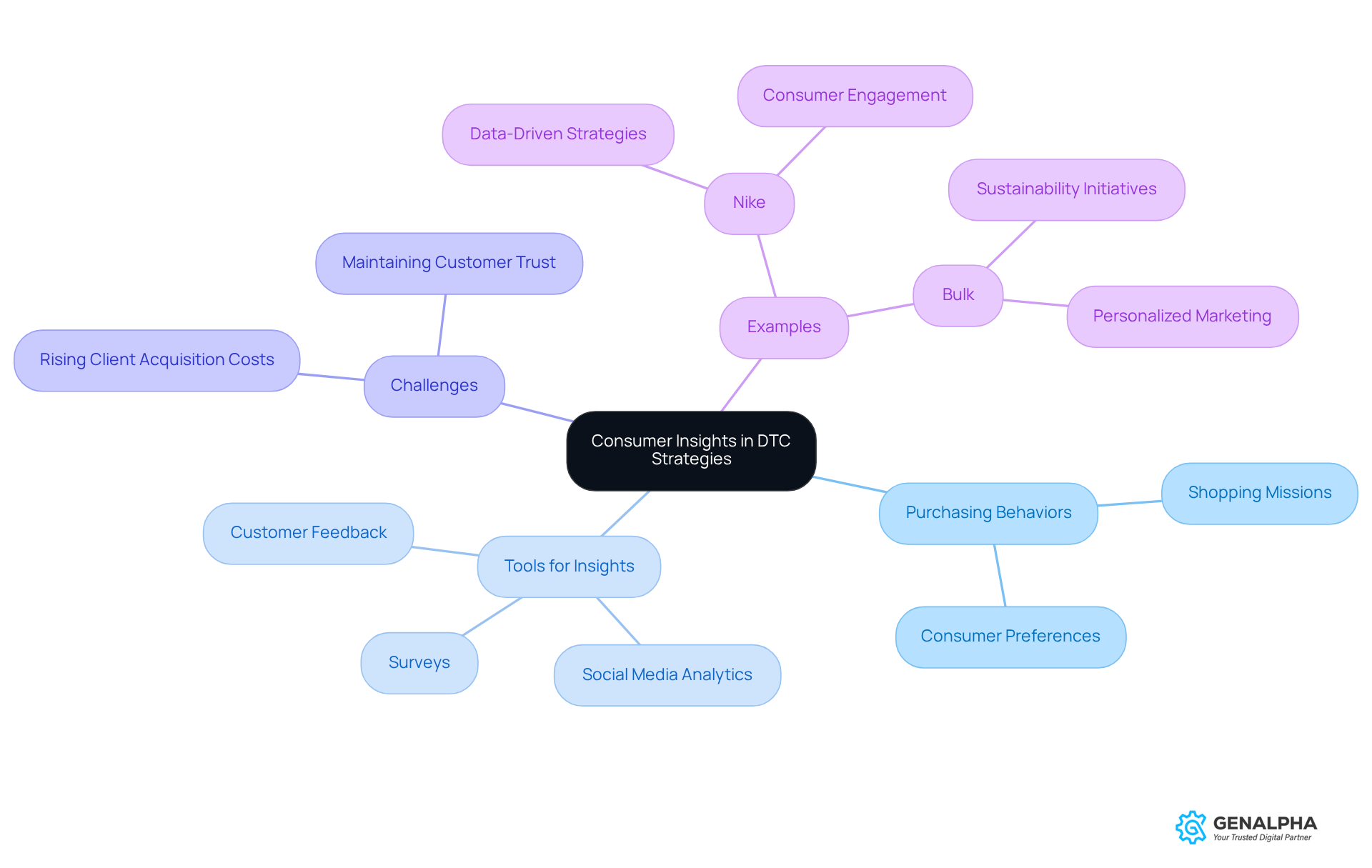
Personalization: Enhancing Customer Experience in DTC
In the direct to consumer ecommerce world, personalization isn’t just a trend; it’s a necessity. Think about it: consumers today expect experiences that really resonate with their unique preferences and behaviors. By tapping into data analytics, companies can craft marketing campaigns that suggest products based on what customers have bought before, and personalize communications to meet specific needs. This targeted approach not only boosts but also builds long-term loyalty, which means more repeat purchases and higher customer lifetime value.
As companies roll out relevant content and offers, they create a shopping experience that’s engaging and fosters emotional connections. This is key to thriving in the competitive direct to consumer ecommerce market. But here’s a word of caution: over-personalization can come off as intrusive. As Lisa Oberst, Director of Email Marketing at Fuel Made, puts it, 'Personalization is no longer a ‘nice-to-have,’ it's a must-have for brands to provide an experience that builds long-term relationships.'
Additionally, integrating chatbots and AI can take these personalized experiences to the next level, giving customers immediate support and tailored recommendations. So, how is your brand approaching personalization? Are you striking the right balance?
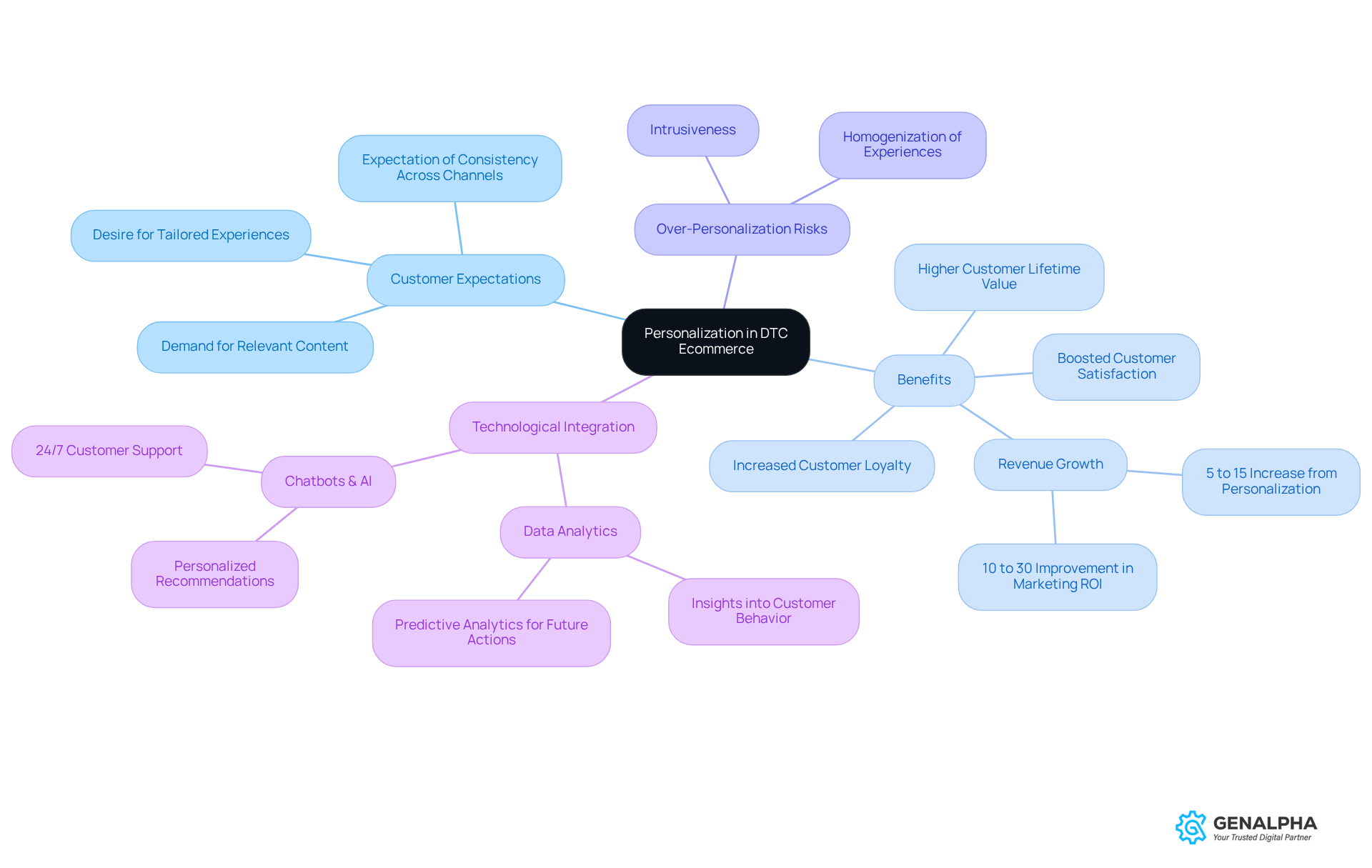
Sustainability: A Driving Force in DTC Consumer Choices
Sustainability is playing a bigger role in how we make purchasing decisions, especially in direct to consumer ecommerce. Have you noticed how brands that embrace eco-friendly practices—like sustainable sourcing and innovative packaging—seem to attract more environmentally conscious shoppers? Research shows that 75% of consumers care about brands' sustainable efforts, which really highlights how important this trend has become.
When companies openly share their , they build trust and loyalty among customers who value ethical consumption. Prachi Bishnoi, Chief Editor at The Sustainable Brands Journal, points out that businesses that embrace sustainability are likely to thrive as consumers become more selective, looking for quality and longevity rather than just affordability.
This strategic alignment not only boosts a brand's reputation but also meets the rising demand for responsible purchasing. So, if companies effectively weave sustainability into their core values, they’re likely to foster stronger customer relationships and pave the way for long-term success. Isn’t it fascinating how this shift is reshaping the competitive landscape of direct to consumer ecommerce?
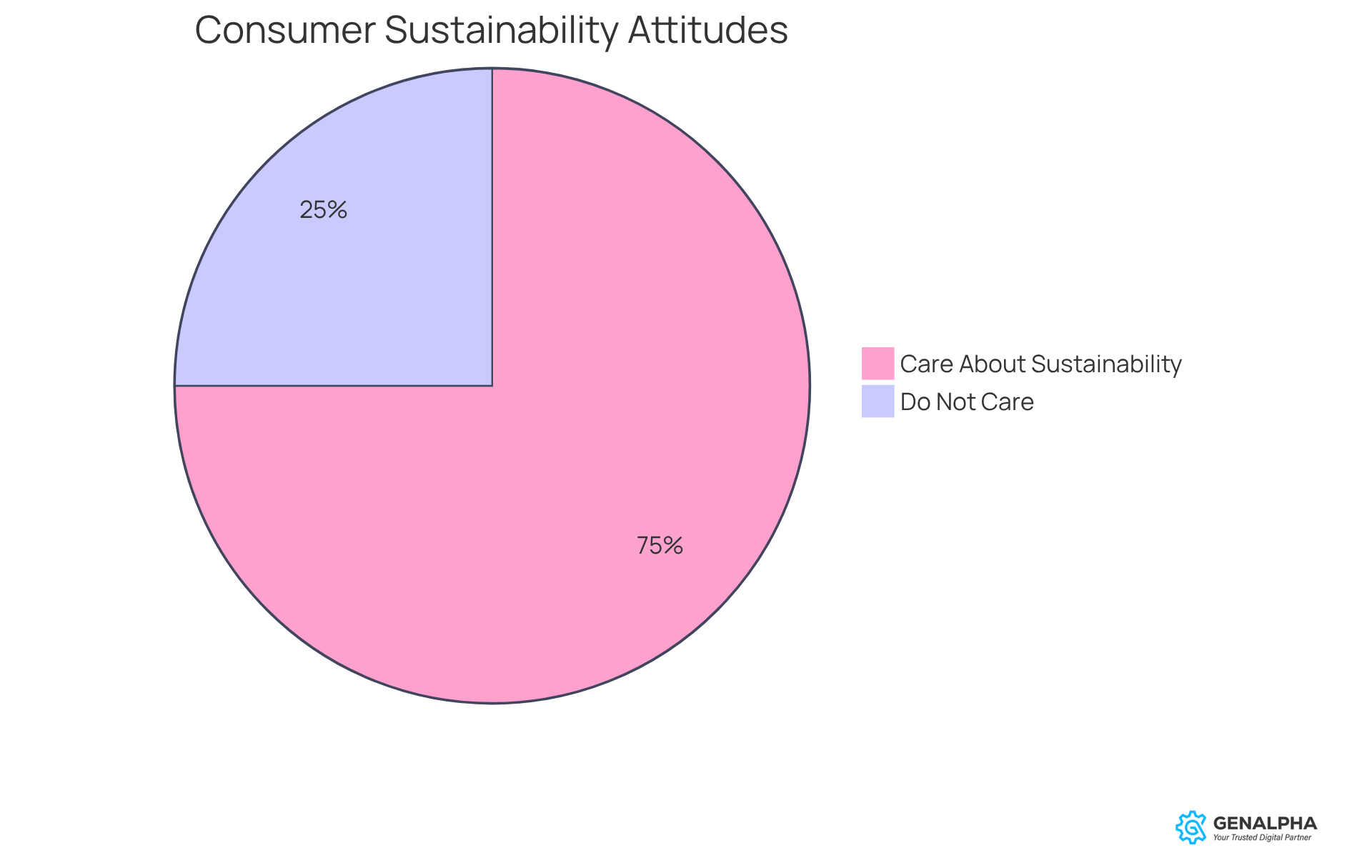
Social Media and Influencer Marketing: Amplifying DTC Reach
Hey there! Have you ever thought about how social media and influencer marketing are game-changers for companies in direct to consumer ecommerce looking to broaden their reach? By teaming up with influencers who really connect with their audience, brands can leverage that established trust and credibility.
Plus, think about all the engaging content on platforms like Instagram and TikTok—it’s a fantastic way to drive traffic to direct to consumer ecommerce websites, build a community, and spark user-generated content. This approach not only boosts visibility but also .
So, how can you get started on this exciting journey?
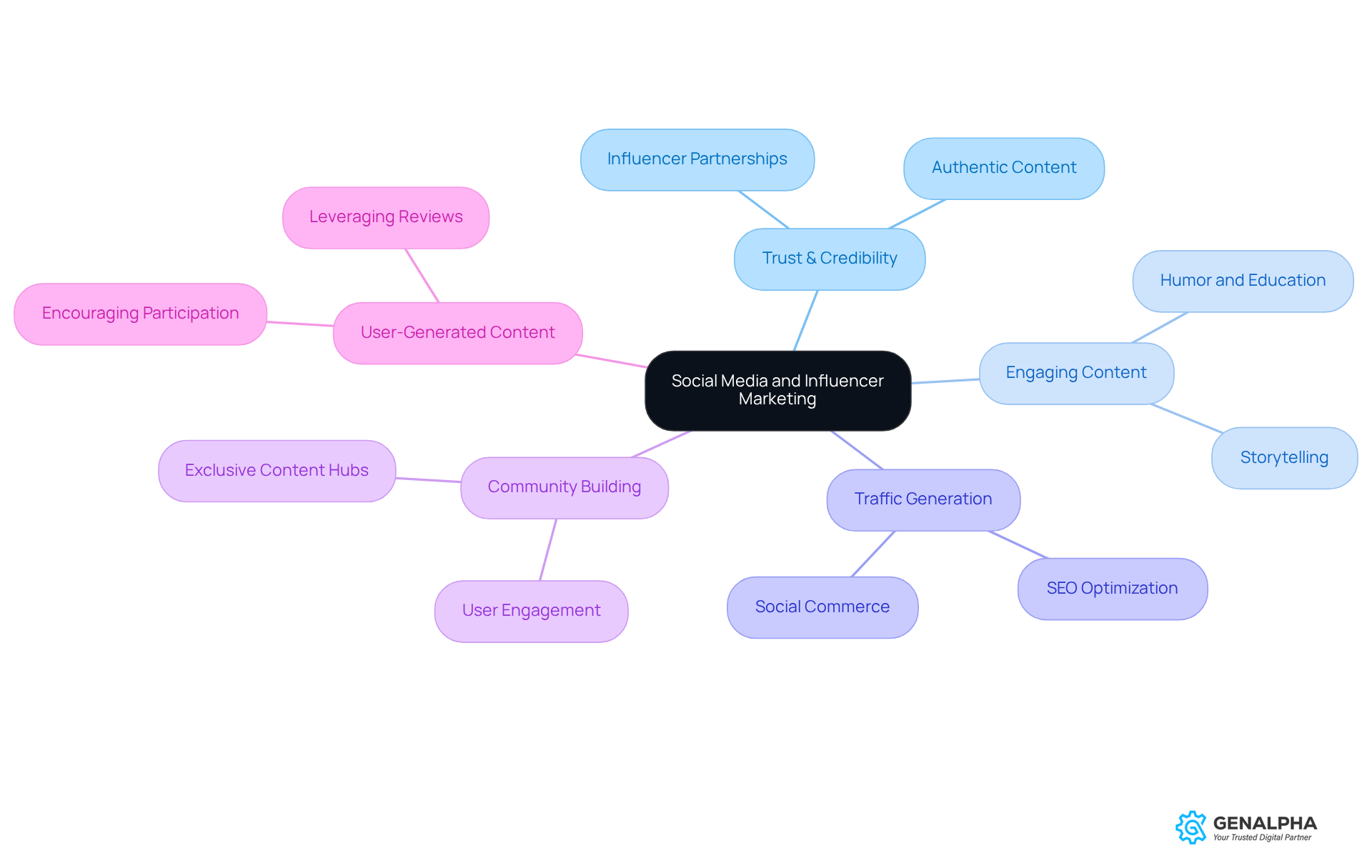
Data-Driven Decisions: Optimizing DTC Operations
Have you ever wondered how data can transform direct to consumer ecommerce operations? Well, is essential for optimizing these operations. Brands today can tap into analytics to track purchaser behavior, assess how well their marketing is working, and refine their inventory management. By leveraging real-time information, companies can make informed choices that not only boost operational efficiency but also enhance client experiences.
This strategic approach does more than just drive sales; it cultivates a culture of continuous improvement within the organization. For instance, think about how efficient inventory management relies on analytics to minimize overstocking and stockouts. This ensures that products are available right when clients want them.
Additionally, consider dynamic pricing models. These can adjust prices based on competitor prices, demand fluctuations, and inventory levels, further fine-tuning inventory management. But it doesn’t stop there! Analytics also supercharge marketing strategies by providing insights into consumer preferences and behaviors. This allows companies to tailor their messaging and campaigns for maximum impact.
As industry experts point out, "AI-driven decision making is revolutionizing marketing by enabling highly personalized strategies that resonate with individual preferences." So, if companies engaged in direct to consumer ecommerce focus on data-driven strategies, they can expect to see improved client satisfaction and loyalty. Ultimately, this leads to sustained growth in a competitive marketplace. What steps are you taking to embrace data in your operations?
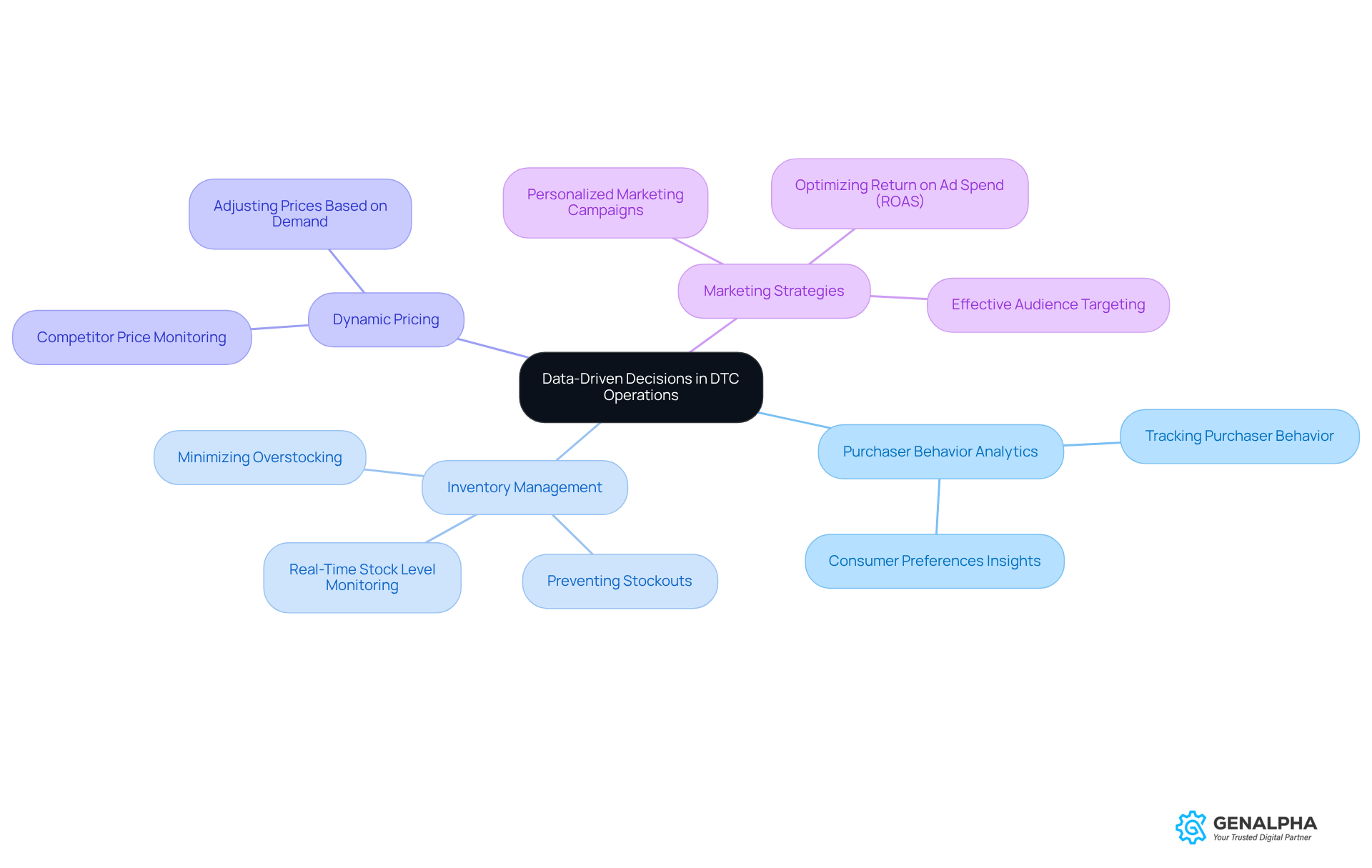
Omnichannel Strategies: Connecting with Consumers Everywhere
For companies in direct to consumer ecommerce, applying omnichannel strategies is super important for engaging with customers across different platforms. By seamlessly blending online and offline channels, businesses can create a shopping experience that matches what consumers want, making things more convenient and building loyalty. Did you know that 73% of shoppers prefer to buy through various channels? This really shows how crucial it is for companies to meet people where they are. Not only does this approach boost customer satisfaction, but it also encourages repeat interactions since shoppers appreciate the flexibility to connect with brands through their favorite channels.
The key to lies in delivering consistent messaging and personalized experiences at every touchpoint. Brands that align their data, inventory, and customer interactions can offer a cohesive experience that resonates with consumers. As industry experts point out, fostering a culture of collaboration between online and offline teams is essential to ensure both channels work together smoothly. Brennan highlights that "there needs to be a culture of collaboration between online and retail so that a win for one is a win for all." By focusing on these elements, DTC companies can effectively navigate the complexities of modern retail and forge lasting connections with their clients through direct to consumer ecommerce. Plus, companies with strong omnichannel strategies retain 89% of clients compared to just 33% for those with weaker strategies, underscoring how impactful effective execution can be on client retention.
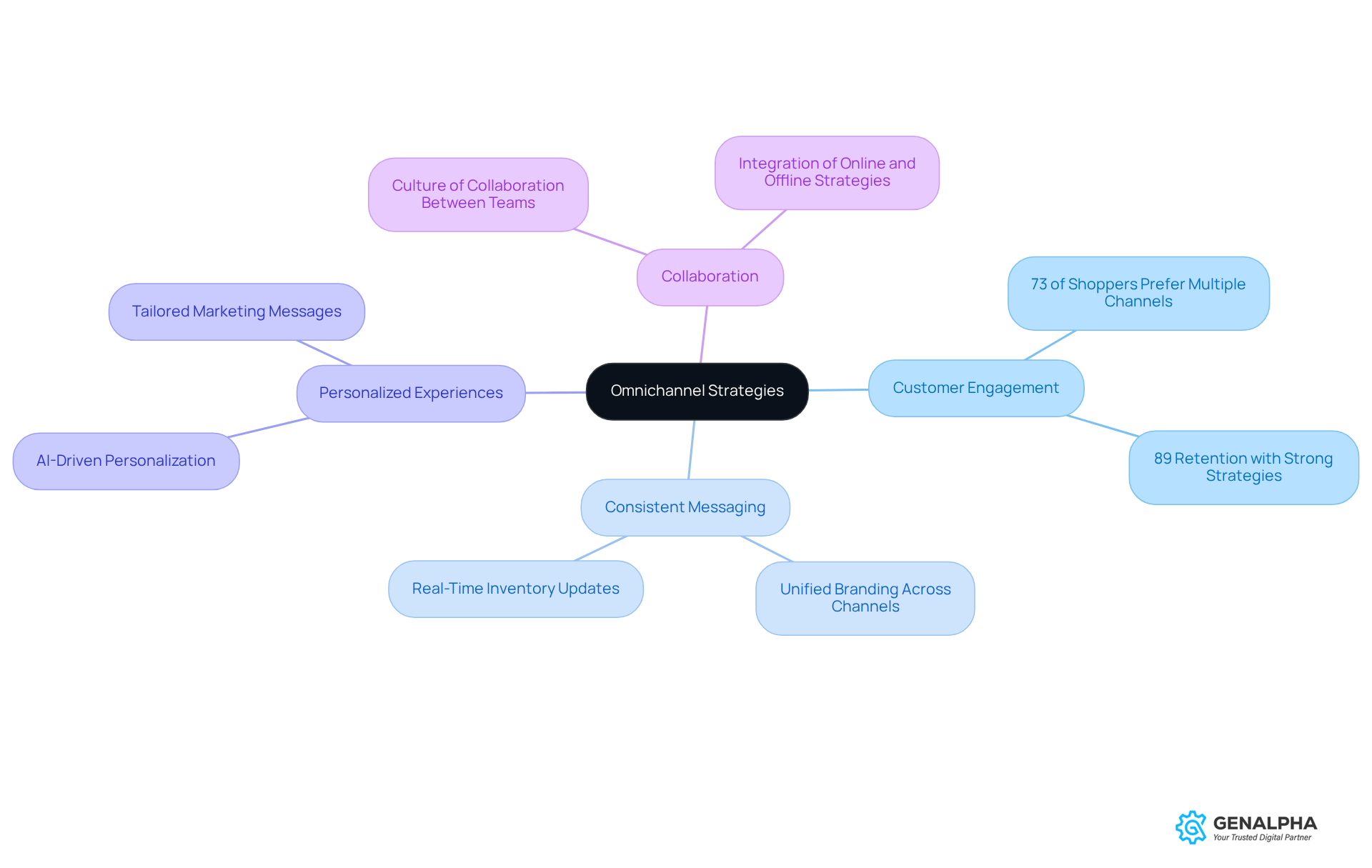
Shipping and Fulfillment: Overcoming DTC Challenges
Shipping and fulfillment can be quite the puzzle for direct to consumer ecommerce companies, particularly as consumers increasingly expect lightning-fast delivery. By 2025, many folks are going to be looking for same-day or next-day options. So, it’s crucial for companies to . Partnering with reliable carriers and using tech for real-time tracking can really amp up operational efficiency.
But that’s not all! Offering flexible shipping choices, like expedited or even free shipping, not only boosts customer satisfaction but also encourages those repeat purchases we all love. It’s all about enhancing those fulfillment processes to keep a competitive edge in direct to consumer ecommerce. Companies that fine-tune their logistics can meet consumer demands more effectively and elevate the overall customer experience.
And let’s not forget about returns! Implementing automated Return Merchandise Authorization (RMA) systems can make the return process smoother, cutting costs and building customer loyalty. By honing in on these logistics strategies, brands engaged in direct to consumer ecommerce can tackle the complexities of fulfillment and truly thrive in a bustling market. So, what are you waiting for? Let’s dive into these strategies together and see how we can make fulfillment a breeze!
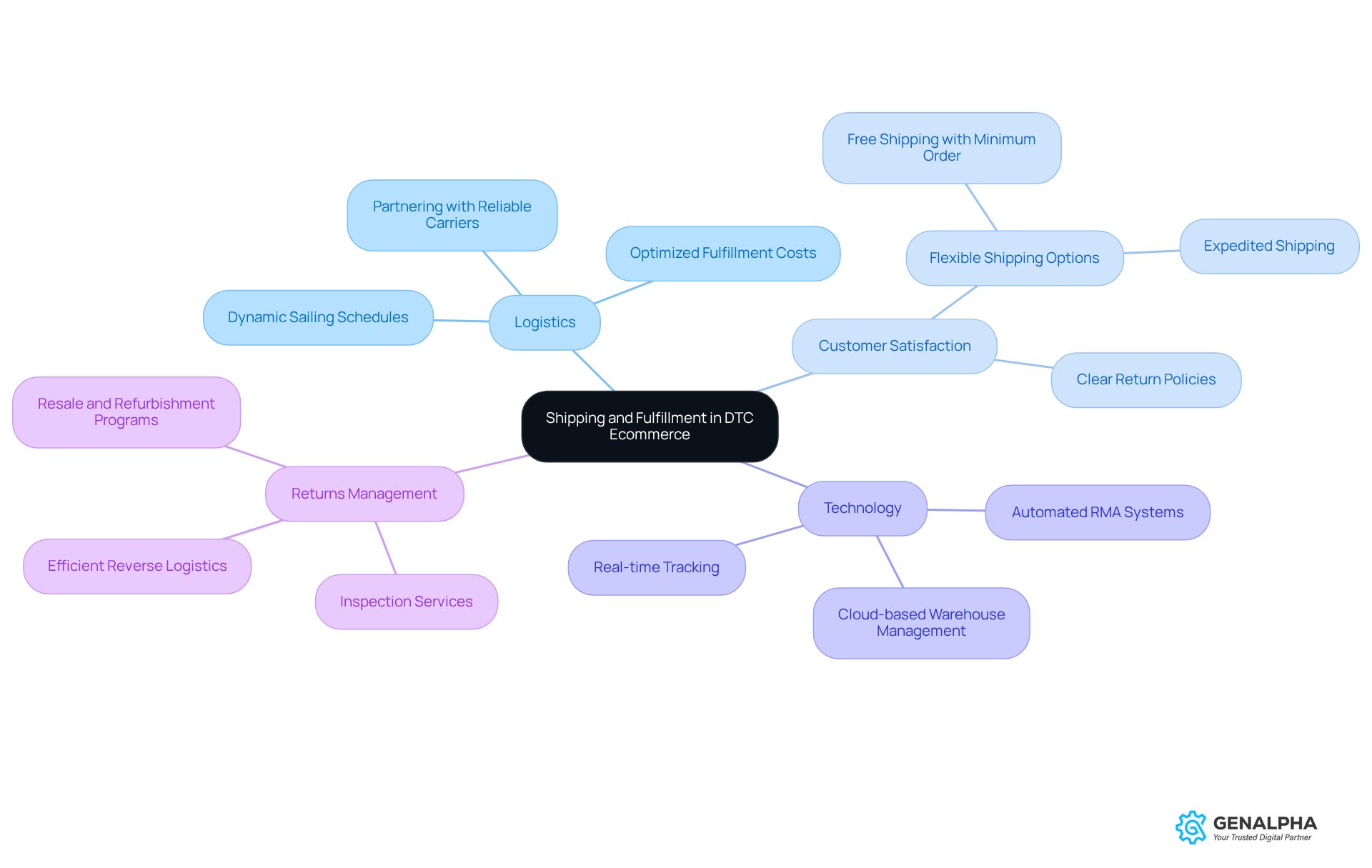
Innovation and Adaptation: Staying Competitive in DTC
In today’s fast-paced direct to consumer ecommerce landscape, staying innovative and adaptable is key to long-term success. Have you noticed how quickly trends change? Brands really need to keep an eye on emerging trends, especially when it comes to technology and what consumers want. For example, with 110.4 million people expected to shop through social channels in 2024, it’s clear that adapting to these changes is vital to stay relevant.
By fostering a culture of innovation, companies can refine their offerings and enhance customer experiences continuously. This proactive approach not only keeps them relevant but also helps them stand out as , positioning them to tackle challenges and seize new opportunities. As consumer expectations evolve, making the most of data-driven insights and embracing new technologies—like AI, which boosts average order value (AOV) and lifetime value (LTV)—is crucial for engaging customers and driving growth.
Additionally, 44% of e-commerce leaders emphasize that flexibility is the most important factor when evaluating global partners. This highlights just how essential it is for companies to remain adaptable. So, how can brands implement this culture of innovation?
- Encouraging collaboration across departments
- Investing in training focused on emerging technologies
are great places to start. Let’s embrace the change together!
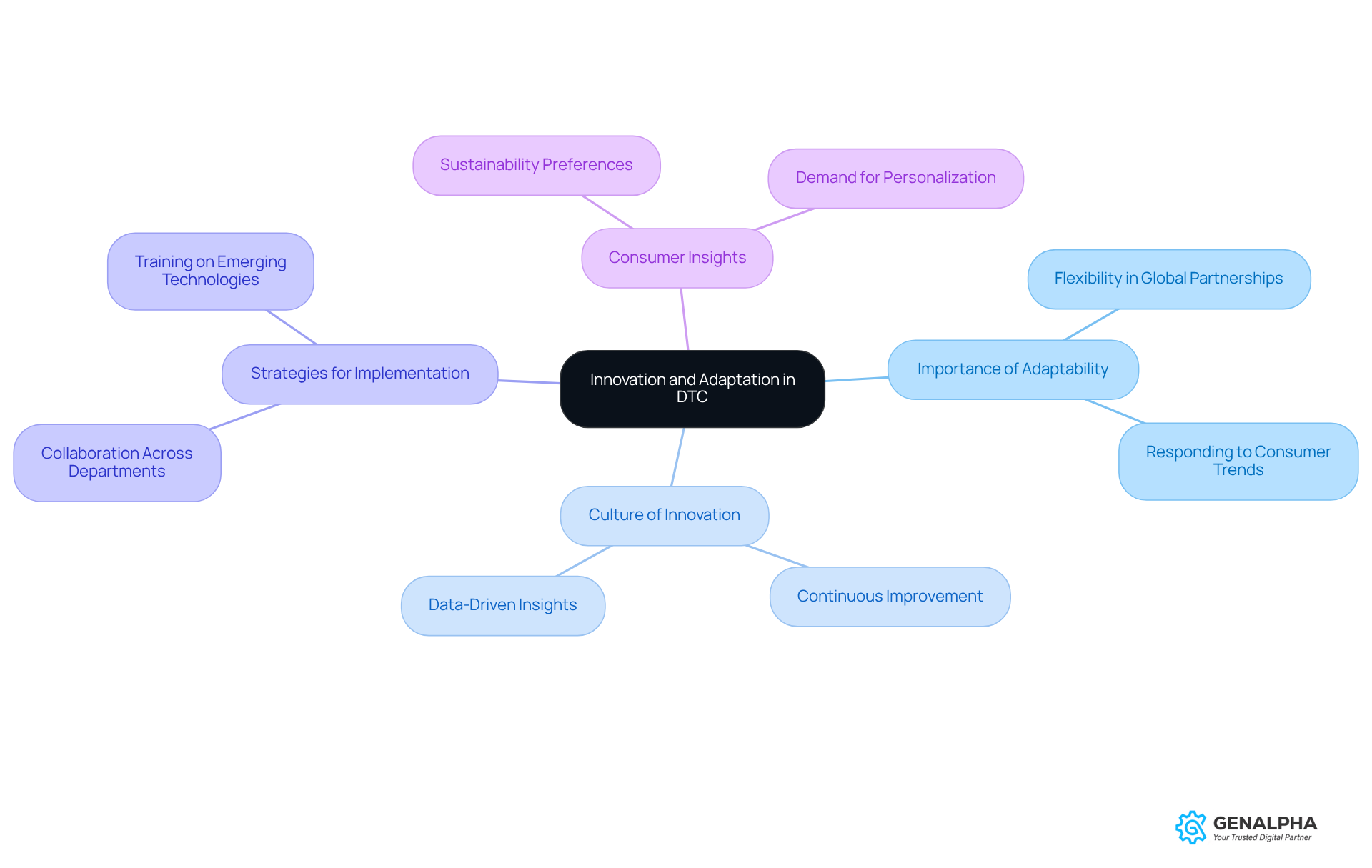
Conclusion
Embracing direct to consumer (DTC) ecommerce isn’t just a trend; it’s a fundamental shift in how brands connect with their customers. Think about it: successful DTC operations rely on innovation, personalization, and truly understanding consumer behavior. By harnessing technology and data, brands can elevate customer experiences and forge lasting relationships, ultimately boosting sales and loyalty.
Throughout this article, we’ve highlighted key strategies like:
- Adopting omnichannel approaches
- Prioritizing sustainability
- Leveraging data-driven insights
These are essential ingredients for DTC success. Just look at brands like GenAlpha Technologies, or digital natives like Warby Parker and Allbirds. They show us how innovative solutions and a customer-centric focus can lead to impressive market advantages. Plus, the emphasis on personalization and sustainability really drives home the evolving expectations of consumers who want brands that resonate with their values and preferences.
As the DTC landscape keeps evolving, it’s vital for brands to stay agile and responsive to market changes. Companies should make innovation and adaptability a priority, cultivating a culture that embraces new technologies and consumer insights. By doing this, they won’t just meet current demands; they’ll also be ready to anticipate future trends, securing their spot in the competitive ecommerce arena. Engaging with these strategies will empower brands to thrive in the direct to consumer space, ultimately leading to happier customers and sustained growth. So, how will you adapt to these changes and seize the opportunities ahead?
Frequently Asked Questions
What is GenAlpha Technologies and what do they offer?
GenAlpha Technologies is a company that reshapes the direct to consumer (DTC) ecommerce landscape with innovative solutions for manufacturers and distributors. Their flagship product, Equip360, optimizes inventory management and boosts digital sales performance.
How does Equip360 benefit businesses?
Equip360 helps businesses connect with clients more effectively, streamlines operations, enhances client satisfaction, and includes features like digital warranty management and robust analytics tools.
What impact does selling directly to consumers have on manufacturers?
Selling directly to consumers strengthens client relationships and experiences, with 82% of manufacturers agreeing on its benefits.
Can you provide an example of a company that benefited from GenAlpha's solutions?
Humphrey Service Parts utilized Equip360 to launch their new eCommerce website, resulting in improved client engagement and increased sales efficiency.
What is the projected growth of the B2B eCommerce industry?
The B2B eCommerce industry is expected to surpass $3 trillion by 2027, highlighting the sales potential for businesses that adopt direct to consumer ecommerce strategies.
What should manufacturers consider when choosing an eCommerce provider?
Manufacturers should choose an eCommerce provider with specialized knowledge in aftermarket sales and ensure seamless integration with backend systems for optimal operations.
How are digital native brands influencing the DTC market?
Digital native brands like Warby Parker and Allbirds utilize online-first strategies and personalized marketing to build strong customer relationships, setting benchmarks for traditional companies.
What innovative strategies do companies like Warby Parker use?
Warby Parker offers a home try-on program that allows customers to experience products before purchasing, enhancing customer engagement.
What is the expected market share for digital native companies by 2025?
Digital native companies are expected to capture a significant share of the direct to consumer ecommerce market by 2025, demonstrating the effectiveness of their strategies.
Why is understanding consumer insights important for DTC strategies?
Understanding consumer insights helps brands tailor their offerings based on purchasing behaviors and preferences, enhancing product development and marketing strategies.
What challenges do companies face in the DTC ecommerce landscape?
Companies face challenges such as rising client acquisition costs, which can affect their growth in the competitive direct to consumer ecommerce market.




